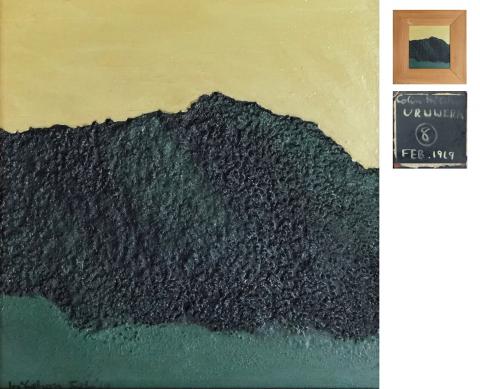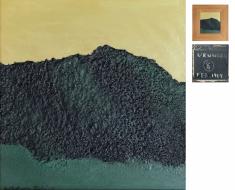Colin McCahon (NZ)
Uruwera 8 (Urewera), 1969
In 1968 Colin McCahon (1919-1987) and his wife Anne were driving along highway 38 past Lake Waikaremoana and through the Urewera ranges. The small series of Urewera paintings of the following year are the artist’s attempt to analyse the thrill and terror he experienced on that road trip. For it was a landscape first ‘seen’ in the face of possible calamity: “we came … through the Urewera country in pouring rain, wipers packed up, at least fifty slips, large and small on the road … and a great lot of luck not to slide sideways over the edge…. After our crossing I’m … scared to return but I think I must.”
In the 1960s McCahon had a newfound appreciation of the connection of Maori to their lands, gained as a result of his daughter’s relationship with a young Maori man, and he would have sensed the redemptive potential of going back to the place he was scared of; of going into the wilderness as a site for self-exploration. As Gordon H. Brown recorded, in the 1960s McCahon intended his landscapes “to throw people into an involvement with the raw land, and also with raw paint … like spitting on the clay to open the blind man’s eyes.”
What McCahon saw from behind the rain-washed car windscreen, and described in a letter to Anna Caselberg, was a land “for those who have learned how to cry.” A few years earlier he had experimented with adding sand and sawdust to synthetic polymer paint in a group of small, square, almost pure black paintings. He returns to these techniques to analyse his experience of the Urewera’s dark, wet, cold vertical bush bluffs. In Urewera 8 green-black synthetic polymer impregnated with sawdust dominates the hillside and a saturated yellow ochre fills the sky space. Symbolically the sawdust permits McCahon to indicate, through the way the stipples catch and reflect light, that even the ‘darkness’ will be penetrated by the ‘light.’ But looking at the whole composition, it seems as if he has turned the landscape upside down. During his drive he says he could not see the sky – it was blotted out – instead the ‘light’ and terror came from a source below, indicated when he wrote that he was amazed they had not slid off the road several times and “down four or five hundred feet into foaming yellow ochre rivers and lakes.” Perhaps, and this may be startling, instead of looking up into a golden sky in this painting, we are looking down a steep slope and into the raging ochre waters. Perhaps. Nevertheless, whether we look down or up, it seems that McCahon is interested in creating an impression of instability and vertigo, resolved symbolically in the painting’s juxtaposition of a threatening black-green and a redemptive saturated golden light.
Colin McCahon, Uruwera 8 (Urewera), February 1969, sawdust, synthetic polymer paint, 305 x 300 mm
Essay commissioned by International Art Centre, Parnell, Auckland, NZ; and published in Important, Early and Rare, 25 March 2015.

